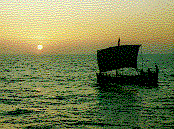
UNANSWERED QUESTIONS
We can learn as many things from the journeys as from the building of the replica ship. It is useful to know how the important differences we saw in its construction will affect the ship at sea. How will the curved keel affect its stability and behaviour? Will the use of beams in building the ship produce a rigid boat that will behave differently from similar contemporary ones? What is the maximum speed the ship can reach? How mobile will it be in the face of different winds and with different cargos? How resistant will it be to adverse wind? These are questions that have occupied for a long time now researchers who have studied ancient ships.
Besides, there are human problems which are of interest to us. How did the four-man crew store and move the cargo? Could they unload at ports without wharves? How did they cook and sleep on the ship, whose open hull was full of merchandise, leaving only small decks on the fore and aft for provisions, protection and dry storage?
The time has come to have first-hand experience of the building of the ship, its itineraries as well as conditions of living and working on a ship that is similar to those that were in operation in the empire of Alexander the Great and his successors. The Institute of Nautical Archaeology of A & M University of Texas and the members of th.e "Kyrenia Ship" expedition are proud to "sail together" with the Hellenic Institute for the Preservation of Nautical Tradition for the successful outcome of this remarkable venture.
Extract from a speech by MICHAEL KATSEV which he gave as Vice-Chairman of INI (Institute of Nautical Archaeology of the A & M University of Texas) at a press conference in Athens, during which HIPNT announced the commencement of work for the building of "Kyrenia I I".
HIPNT: 'Án ancient ship sails again" Pireus,1982, p.16.
Go back to the previous page"
Wednesday, May 29, 1996 10:50:06 PM

